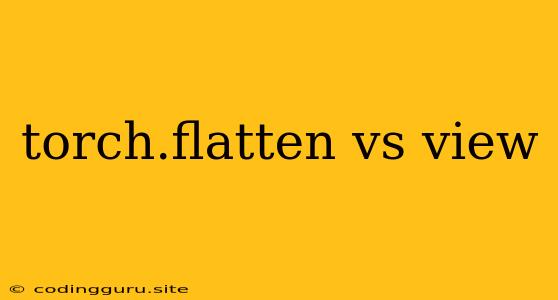Understanding torch.flatten vs view in PyTorch
When working with tensors in PyTorch, reshaping your data is a common operation. You might need to flatten a multi-dimensional tensor into a one-dimensional vector, or reshape it into a different matrix structure. PyTorch provides two methods for achieving this: torch.flatten and view. While both methods can be used to reshape tensors, they have key differences that impact how they modify the underlying data. This article explores the nuances of torch.flatten and view to help you choose the best approach for your specific situation.
What is torch.flatten?
torch.flatten is a method that creates a new tensor containing a flattened version of the input tensor. It essentially converts a multi-dimensional tensor into a one-dimensional tensor, regardless of the original shape. The torch.flatten method operates on the original tensor without modifying it directly.
Key Features of torch.flatten:
- Creates a new tensor: It does not modify the original tensor in-place.
- Flattens the tensor: It reshapes the tensor into a one-dimensional array.
- Contiguous memory: The flattened tensor is guaranteed to be stored in contiguous memory.
Here's an example:
import torch
x = torch.tensor([[1, 2, 3], [4, 5, 6]])
print(x)
# Output:
# tensor([[1, 2, 3],
# [4, 5, 6]])
flattened_x = torch.flatten(x)
print(flattened_x)
# Output:
# tensor([1, 2, 3, 4, 5, 6])
What is view?
view is a method that returns a new view of the existing tensor. It allows you to reshape the tensor into a different shape without creating a copy of the data. This means that view operates on the same underlying memory as the original tensor.
Key Features of view:
- Creates a new view: It does not create a copy of the tensor's data.
- Reshapes the tensor: You can define the desired shape for the new view.
- Requires contiguous memory: For
viewto work correctly, the original tensor must have contiguous memory. If it doesn't, you'll need to usecontiguous()first.
Here's an example:
import torch
x = torch.tensor([[1, 2, 3], [4, 5, 6]])
print(x)
# Output:
# tensor([[1, 2, 3],
# [4, 5, 6]])
reshaped_x = x.view(-1) # Flattening using view
print(reshaped_x)
# Output:
# tensor([1, 2, 3, 4, 5, 6])
Differences between torch.flatten and view
-
Data Modification:
torch.flattencreates a new tensor, leaving the original tensor unchanged.viewoperates on the same data, providing a new view of the existing tensor. -
Memory Usage:
torch.flattenallocates new memory for the flattened tensor.viewreinterprets the existing memory, creating a view without allocating new memory. -
Contiguous Memory:
torch.flattenguarantees a contiguous memory layout for the flattened tensor.viewrequires the original tensor to have contiguous memory; otherwise, it raises an error.
When to use torch.flatten vs view
Use torch.flatten when:
- You need a copy of the flattened tensor.
- You want to ensure that the flattened tensor is stored in contiguous memory.
- You want a more predictable and reliable way of flattening, regardless of the original tensor's memory layout.
Use view when:
- You want a more efficient way to reshape the tensor without copying the data.
- You are confident that the original tensor has contiguous memory.
- You are working with the data in-place and need to avoid creating unnecessary copies.
Examples and Practical Applications
Example 1: Flattening for Neural Network Input:
Neural networks often require input data to be flattened into a one-dimensional vector. torch.flatten can be used to efficiently flatten your data before feeding it to the network.
import torch
import torch.nn as nn
class SimpleNet(nn.Module):
def __init__(self):
super(SimpleNet, self).__init__()
self.fc1 = nn.Linear(12, 8)
def forward(self, x):
x = torch.flatten(x, 1) # Flatten for input to the first layer
x = self.fc1(x)
return x
# Example Usage
model = SimpleNet()
input_tensor = torch.randn(4, 3, 4) # Assuming input shape is (batch_size, channels, height, width)
output = model(input_tensor)
print(output.shape) # Output: torch.Size([4, 8])
Example 2: Reshaping for Convolutional Layers:
When dealing with images in deep learning, you may need to reshape tensors to match the input requirements of convolutional layers. view can be helpful for this purpose.
import torch
x = torch.randn(1, 3, 28, 28) # Example image tensor
print(x.shape) # Output: torch.Size([1, 3, 28, 28])
reshaped_x = x.view(1, -1, 14, 14) # Reshape for convolution
print(reshaped_x.shape) # Output: torch.Size([1, 12, 14, 14])
Conclusion
torch.flatten and view offer different approaches to reshaping tensors in PyTorch. torch.flatten is a reliable method for creating a flattened copy of the tensor, while view provides a more memory-efficient way to reshape the data in-place. Understanding their distinctions and applying them appropriately can make your code more efficient and easier to manage. Always consider the specific requirements of your application when choosing between these two methods.
